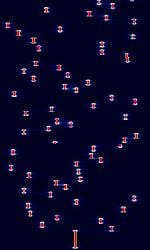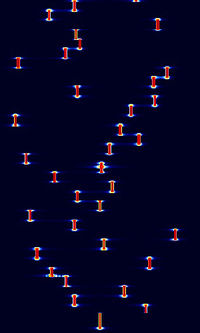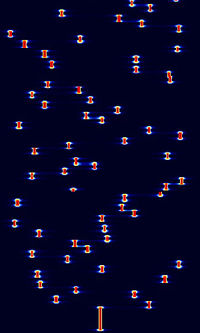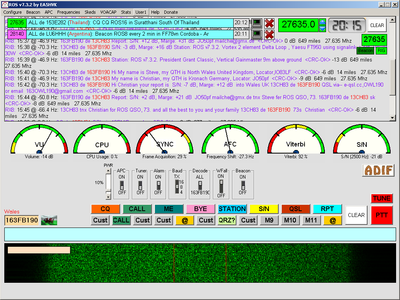ROS
ROS is an amateur radio teletype free running QSO mode designed for low signal/high noise conditions. ROS was designed by José Alberto Nieto Ros EA5HVK.
ROS implements a combination of FHSS (Frequency Hopping Spread Spectrum), DSSS (Direct Sequence Spread Spectrum) and 2G (Second Generation) CDMACode Division Multiple Access (Code Division Multiple Access), The modem deployed's a 144 MFSKMultiple Frequency Shift-Keying phase continuous single tone, modulation scheme, ROS may be amplified by non-linear Tx path. Class c/d/e.
The unique deployment of 2G technology, similar to mobile phones, allows multiple simultaneous access to a single channel. The provision of the ‘decode from’ function, providing selection of a single call-sign only for RXReceive,A QSO may take place, isolated from the channel traffic, at the rated sensitivity for the selected speed, similar to the connected state of a packet QSO.
ROS provides efficient use of channel capacity and Data rate/power ratio and is exceptionally robust, being well suited to QRPIn amateur radio, QRP operation refers to transmitting at reduced power while attempting to maximize one's effective range. Dx, low power chat and disturbed paths, i.e., Polar and NVIS 5 MHzMegaHertz (MHz) 10^6 Hz, where conventional data modes are unable to provide communication's.
History[edit]
The ROS project has evolved, with various modes and options being added and deleted, uniquely modes are linked to bands
- 1 baudBaud (unit symbol Bd) is the unit for symbol rate or modulation rate in symbols per second. experimental HFHigh Frequency (3-30 MHz) 2.2 kHzKiloHertz (kHz) 10^3 Hz HFHigh Frequency (3-30 MHz) FHSS MFSKMultiple Frequency Shift-Keying
- VHFVery High Frequency (30-300 MHz) EME Mode, 50 HzHertz (Hz), unit of frequency, defined as one cycle per second (1 Hz). B/W MFSKMultiple Frequency Shift-Keying Live chat mode for 145 MHzMegaHertz (MHz) 10^6 Hz EME, 1500Hz AFC lock range
- 2000 HzHertz (Hz), unit of frequency, defined as one cycle per second (1 Hz). and 500 HzHertz (Hz), unit of frequency, defined as one cycle per second (1 Hz). b/w ROS-HFHigh Frequency (3-30 MHz)
- ROS Repeater, Providing on-channel and /or CAT control cross band repeater
- ROS MF1 and MF7 Data modes, 100Hz B/W Developed during the UK 500 NOV
- ROS MF2 and MF7 Full chr's set, MF2 same s/n as wspr 2, live rtty chat mode, MF7, same rate as psk32, -10 db lower s/n
- ROS Remote configuration for Beacon sites
- ROS Remote access, allowing remote web access to full Tx/Rx functions
- ROS Text delivery, allowing SMS messages to be routed to other users
- ROS Wide-Hop Base Band FHSS Concept mode developed [ only data mode to continue working on 10MHz when band jammed by OTHOver The Horizon (very long range) radar]
- The latest version, provides only ROS-2K 4/8/16 Modes
In Keeping with the theme of constant development, Version 7-4-0 upgrade release 9/11/2016, introduced changes to modulation code structure, providing enhancements to print quality in marginal band conditions . Previous Versions to V7-4-0 are not compatible with the new coding.
Samples[edit]
| 4 BaudBaud (unit symbol Bd) is the unit for symbol rate or modulation rate in symbols per second. | 8 BaudBaud (unit symbol Bd) is the unit for symbol rate or modulation rate in symbols per second. | 16 BaudBaud (unit symbol Bd) is the unit for symbol rate or modulation rate in symbols per second. |
|---|---|---|
- Decode of sample audio files [V 7-3-2]
- RX4: 16:03 @ 0.0 HzHertz (Hz), unit of frequency, defined as one cycle per second (1 Hz).: The quick brown fox jumps over the lazy dog 1234567890 <CRC-OK> +13 dBThe decibel (dB) is a logarithmic unit used to express the ratio of two values of a physical quantity, here the strength of a received signal.
- RX8: 16:04 @ 0.0 HzHertz (Hz), unit of frequency, defined as one cycle per second (1 Hz).: The quick brown fox jumps over the lazy dog 1234567890 <CRC-OK> +13 dBThe decibel (dB) is a logarithmic unit used to express the ratio of two values of a physical quantity, here the strength of a received signal.
- RX16: 16:05 @ 0.0 HzHertz (Hz), unit of frequency, defined as one cycle per second (1 Hz).: The quick brown fox jumps over the lazy dog 1234567890 <CRC-OK> +12 dBThe decibel (dB) is a logarithmic unit used to express the ratio of two values of a physical quantity, here the strength of a received signal.
Frequencies[edit]
The HFHigh Frequency (3-30 MHz) frequencies currently used for ROS [ v7-4-0] are:
- 1.840 MHzMegaHertz (MHz) 10^6 Hz
- 3.558 MHzMegaHertz (MHz) 10^6 Hz
- 5.367 MHzMegaHertz (MHz) 10^6 Hz
- 7.046 MHzMegaHertz (MHz) 10^6 Hz
- 10.130 MHzMegaHertz (MHz) 10^6 Hz
- 14.103 MHzMegaHertz (MHz) 10^6 Hz
- 18.108 MHzMegaHertz (MHz) 10^6 Hz
- 21.122 MHzMegaHertz (MHz) 10^6 Hz
- 24.192 MHzMegaHertz (MHz) 10^6 Hz
- 27.635 MHzMegaHertz (MHz) 10^6 Hz [Citizens Band]
- 28.140 MHzMegaHertz (MHz) 10^6 Hz
- 50.245 MHzMegaHertz (MHz) 10^6 Hz
- 144.980 MHzMegaHertz (MHz) 10^6 Hz
Decoding Software[edit]
- Hobby Level Software
Video Examples[edit]
- ROS16 HF Real time QSO
- ROS2 MF Data -25 dB s/n test
- Video demonstration of the 'ROS-Concept Mode': Wide HOP FHSS
Additional Links[edit]
Additional Images[edit]
ROS 2G Multi access,single channel use on 27.635 MHzMegaHertz (MHz) 10^6 Hz




